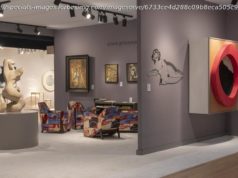Arthur J. Williams spent 12 years in prison, where he learned to paint — and now he’s a successful artist in Chicago whose work on canvas features all things currency.
The man who strolled into Arthur J. Williams’ art gallery in Bridgeport a few years ago was well-spoken, dressed nicely and knew what he wanted — but something about the visitor made Williams uneasy.
“Something just hit me, man, like this ain’t right,” Williams remembers.
Then Williams looked closely at the $12,000 cashier’s check the man presented for one of the gallery’s paintings. It was from a bank in San Francisco; that was odd for a guy who’d said he lived in Chicago. The check turned out to be a fake.
If Williams had been hoodwinked, it would have been a fitting irony for a man who was once dubbed the “King of Counterfeit” and printed an estimated $10 million in fake bills during the course of his career — including about $500,000, he said, on Chicago Sun-Times scrap newsprint.
Williams also spent 12 years in the penitentiary for his crimes. He’s been out for 10 years and is now a successful artist. But he’s still obsessed with money: It seeps into all of his work — sometimes like a watermark underlying a portrait of the Greek philosopher Socrates, whose writings Williams studied while incarcerated. Other times, extravagantly, as in a giant crumpled $100 bill with a velvety purple sheen.
Williams bristles at the suggestion that his is a distasteful redemption story because, in a sense, he’s still profiting form his misdeeds.
“Anyone who questions my reasoning now, I ask, have you grown up with a bipolar mother in the projects with no food, with no hot water for two years? Were you forced to break into parking meters so you could feed your brother and sister?,” Williams asked rhetorically.
We met recently in a lounge on the 21st floor of downtown’s LondonHouse Chicago, where some of his work is on display through Sept 20. He wore Prada eyeglasses, gleaming Air Jordan sneakers and a red Armani polo shirt. He’s muscular with a slight paunch, his salt-and-pepper hair short and slicked back, on his way to Nonna Soluri’s Italian Deli in Bridgeport for an Italian beef (“easy dip, easy hot”) after our chat.
Williams’ mother, when she could hold down a job, was a waitress. His father ditched the family when the boy was 12. Williams says he was “raised by the streets.” His mentors in Bridgeport included Jerry Scalise, the mobster famous for stealing the 45-carat Marlborough Diamond from a London jewelry store.
A friend of his mother’s, nicknamed DaVinci, introduced a teenage Williams to counterfeiting — after scolding him for stealing a car.
Домой
United States
USA — Art Chicago counterfeiter-turned-painter still finds money much to his liking






